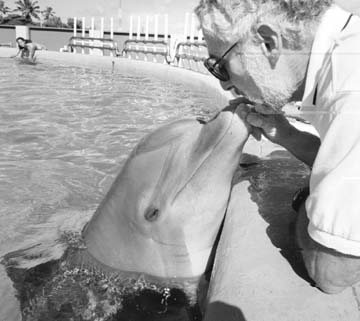
STAR-BULLETIN / SEPTEMBER 2000
Akeakamai, shown here with Lou Herman at the Kewalo Basin Marine Mammal Laboratory, has a tumor in her mouth.
Dolphin to undergo
cancer surgeryRadioactive seeds will be used
to treat a tumor in its mouth
Dr. John Lederer is preparing to perform groundbreaking cancer surgery on a 420-pound female more than 8 feet long at the Queen's Medical Center.
She's 27-year-old Akeakamai, one of three bottlenose dolphins at the Kewalo Basin Marine Mammal Laboratory.
She has a tumor on the floor of her mouth, which Lederer plans to treat with brachytherapy next month, said Louis Herman, a University of Hawaii psychologist who founded the Kewalo research facility.
The procedure, used to treat prostate and other cancers, involves implanting radioactive seeds directly in a tumor site.
Lederer, an oncologist and medical director of Queen's Nae'a Radiation Oncology Department, introduced brachy-therapy here in 1999.
He said he will use the same kind of general approach on Akeakamai that he uses for human patients, but it will be a little different.
A computer plan is being generated for Akeakamai's surgery to map placement of the seeds, he said.
Also, he added: "We're concerned over the level of sedation and how quiet she is. ... The key is to try to think about potential problems and prepare as much as possible."
Through complicated planning by Queen's and the Kewalo laboratory, the dolphin was removed from her pool, put on a stretcher, lifted by crane over a fence and placed in a truck for a trip to Queen's on July 20 for a CAT scan.
Anesthesia cannot be used on dolphins, Herman pointed out, so she was sedated to keep her as still as possible.
"What we wanted to do was investigate further whether the cancer remained localized or had spread to other organs," he said. "It was very good news. There was no sign of metastasizing, so the cancer has not spread."
After completing the scan, Lederer implanted three titanium markers, each about the size of a staple, into the tumor to map the area for seed implantation, Herman said.
He said Dr. Sam Ridgway, with the U.S. Navy Marine Mammal Program in San Diego, who has taken CAT scans of dolphins for research, is sending him "normal" scans for reference purposes.
Herman said the dolphin's tumor probably started four or five years ago and grew gradually. It was diagnosed about 2 1/2 years ago.
He said Akeakamai, "the world's most educated dolphin," has been treated in various ways by Dr. Carolyn McKinnie, the Kewalo lab's veterinarian. Laser treatment and some anticancer agents injected into the tumor site helped, he said, "but we really haven't been able to get her into remission or resolve the tumor."
If it invades the jaw, it could affect the dolphin's hearing, he said, noting research at the lab has shown sound reaches a dolphin's ears through the lower jaws.
Brachytherapy was proposed as an alternative therapy, he said.
Lederer said he had heard about the dolphin's tumor from a veterinarian some time ago and commented that "temporizing kinds of measures ... wouldn't do the job on the tumor."
Based on knowledge of human tumors, he said, "If we really wanted to get a grip on it, it entailed something along the lines we're headed on to do."
Herman said, "Queen's has been just incredibly cooperative and interested and excited by the prospect of helping out."
He said Akeakamai's outing from the pool and back took about four hours.
"As always, when we go through a procedure, the first thing she wants back in the water is to eat," he said. "Aside from the tumor, you wouldn't know anything is wrong with her."
She greets everyone, socializes, participates in research, and "if you ask for one jump, she'll give you five," he said.
